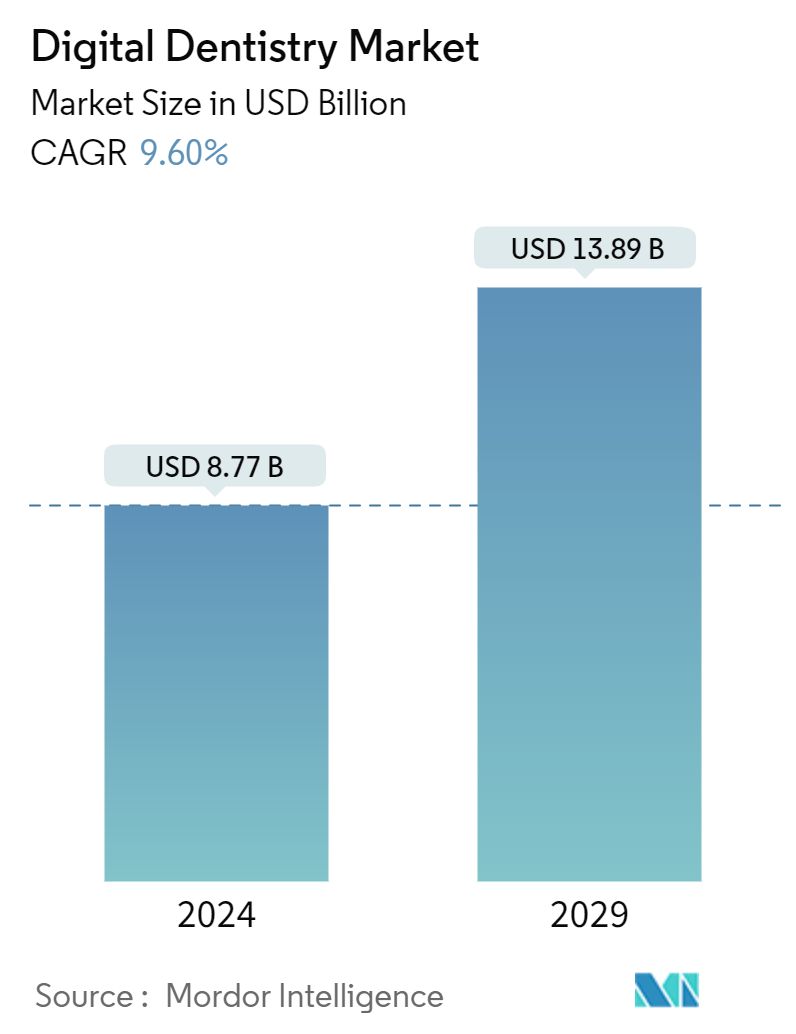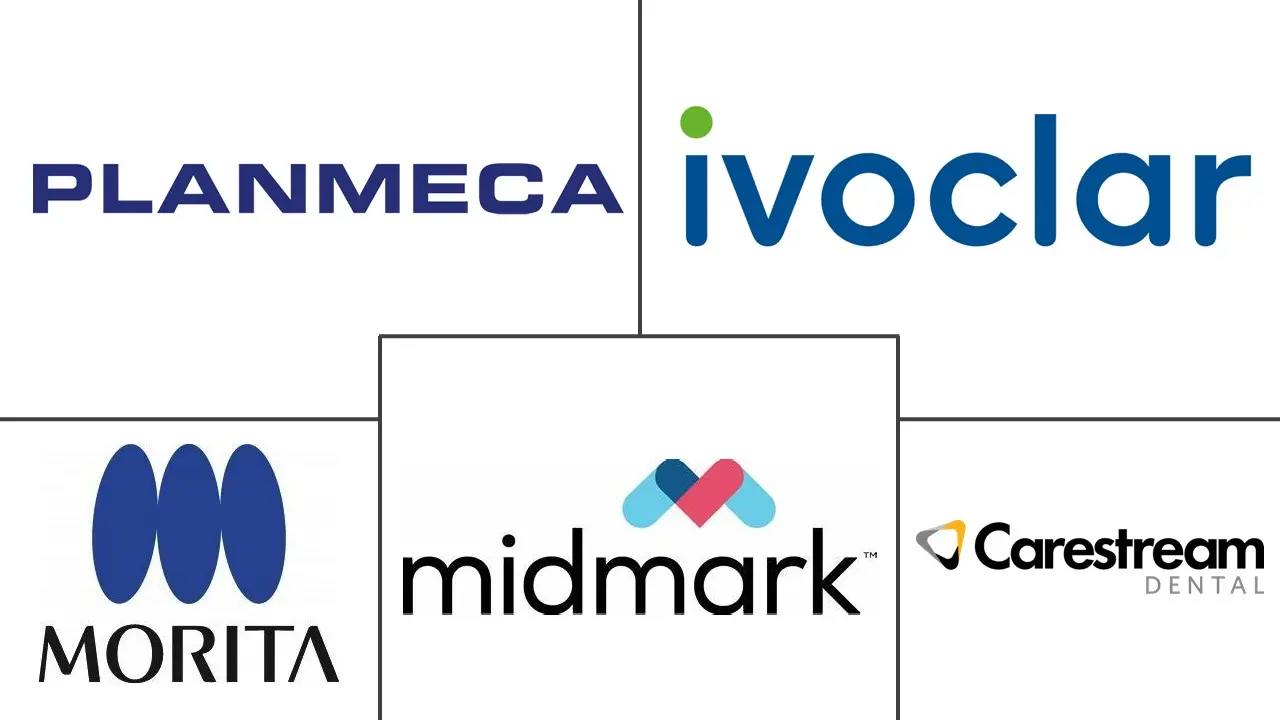Market Size of Digital Dentistry Industry

| Study Period | 2019 - 2029 |
| Market Size (2024) | USD 8.77 Billion |
| Market Size (2029) | USD 13.89 Billion |
| CAGR (2024 - 2029) | 9.60 % |
| Fastest Growing Market | Asia-Pacific |
| Largest Market | North America |
| Market Concentration | Medium |
Major Players
*Disclaimer: Major Players sorted in no particular order |
Digital Dentistry Market Analysis
The Digital Dentistry Market size is estimated at USD 8.77 billion in 2024, and is expected to reach USD 13.89 billion by 2029, growing at a CAGR of 9.60% during the forecast period (2024-2029).
Factors like the increasing focus on digital dentistry, the growing geriatric population, and new product launches by the market players are boosting the market growth.
The high incidence of dental and oral diseases among the population raises the demand for effective intraoral scanners and digital devices early to detect and measure the depth of the condition, hence propelling the market growth. For instance, according to an article published in Frontier in Public Health in September 2023, by 2050, the projected number of individuals aged 16 and above with carious teeth is set to reach 15.504 million in the United Kingdom. Among this group, older adults are expected to make up 62.06% of the total, marking an 89.4% increase from 5.079 million in 2020 to an estimated 9.623 million by 2050. Thus, the high burden of dental disaeses is expected to increase demand for dental procedures and is likely to contribute to market growth over the forecast period.
The rising focus of companies on developing digital workflows and digital platforms, as well as growing collaboration with other tech companies, are also expected to boost the market growth over the projected period. For instance, in September 2022, 3Shape TRIOS 5 Wireless, a completely new, state-of-the-art intraoral scanner was launched to help dentistry to go digital with dentistry. Also, in May 2022, Dentsply Sirona launched a cloud-based DS Core digital dentistry platform, which was designed to enhance digital workflows with benefits for dentists, dental labs, and patients globally, by collaborating with Google Cloud.
The growing geriatric population is leading to the increasing demand for dental prosthetics, which supports the market growth as prosthetics are developed with the help of 3D printing technology. For instance, a wide range of medical sectors finds 3D printing attractive as it makes precise production simpler and makes it possible to design complicated geometries that are customized to a patient. It also saves time and money by reducing human labor. Therefore, the reduction in cost and increasing benefits of 3D printing technologies are expected to boost the adoption of 3D printing of dental prosthetics, hence boosting the market growth.
Hence, owing to factors such as the increasing aging population, and the high burden of dental and oral diseases among the population, the market studied is expected to grow over the projected period. However, the high cost associated with implementation is likely to restrain the growth of the digital dentistry market over the forecast period.
Digital Dentistry Industry Segmentation
As per the scope, digital dentistry uses dental technologies or devices that incorporate digital or computer-controlled components to perform dental procedures in place of mechanical or electrical tools. Digital dentistry can make dental procedures more efficient compared to mechanical tools for both restorative and diagnostic purposes. The digital dentistry market is segmented by type and geography. By type, the market is segmented as instruments and consumables. By end users, the market is segmented as hospitals, dental clinics, and other end users. The report also covers the estimated market sizes and trends for 17 countries across major regions globally. The report offers the value (in USD) for the above-mentioned segments.
| By Type | |
| Instruments | |
| Consumables |
| By End User | |
| Hospitals | |
| Dental Clinics | |
| Other End Users |
| Geography | ||||||||
| ||||||||
| ||||||||
| ||||||||
| ||||||||
|
Digital Dentistry Market Size Summary
The digital dentistry market is experiencing robust growth, driven by an increasing focus on digital solutions and the expanding geriatric population. The market's expansion is further supported by the rising prevalence of dental and oral diseases, which necessitate the use of advanced intraoral scanners and digital devices for early detection and measurement. The development of digital workflows and platforms, along with collaborations between tech companies, is also contributing to market growth. Innovations such as state-of-the-art intraoral scanners and cloud-based digital dentistry platforms are enhancing digital workflows, benefiting dentists, dental labs, and patients globally. Additionally, the adoption of 3D printing technology for dental prosthetics is gaining traction, offering cost-effective and precise solutions tailored to individual patient needs.
The hospital segment is poised for significant growth due to the increasing adoption of new technologies and digital workflows in dental care. The demand for digital dentistry products is rising, enabling dentists to provide customized solutions and improving the efficiency of dental procedures. The establishment of digital dentistry clinics is further augmenting the market, as these facilities leverage advanced technologies to deliver high-quality dental care. North America is expected to witness substantial growth, fueled by technological advancements and increased product launches. Collaborations and partnerships among key players are enhancing market presence and driving innovation. The market remains fragmented, with numerous small and large players actively engaging in strategic initiatives to maintain their competitive edge.
Digital Dentistry Market Size - Table of Contents
-
1. MARKET DYNAMICS
-
1.1 Market Overview
-
1.2 Market Drivers
-
1.2.1 Increasing Focus on Digital Dentistry
-
1.2.2 Increasing Geriatric Population
-
-
1.3 Market Restraints
-
1.3.1 High Cost Associated With Implementation
-
-
1.4 Porter's Five Force Analysis
-
1.4.1 Threat of New Entrants
-
1.4.2 Bargaining Power of Buyers/Consumers
-
1.4.3 Bargaining Power of Suppliers
-
1.4.4 Threat of Substitute Products
-
1.4.5 Intensity of Competitive Rivalry
-
-
-
2. MARKET SEGMENTATION (Market Size by Value - USD million)
-
2.1 By Type
-
2.1.1 Instruments
-
2.1.2 Consumables
-
-
2.2 By End User
-
2.2.1 Hospitals
-
2.2.2 Dental Clinics
-
2.2.3 Other End Users
-
-
2.3 Geography
-
2.3.1 North America
-
2.3.1.1 United States
-
2.3.1.2 Canada
-
2.3.1.3 Mexico
-
-
2.3.2 Europe
-
2.3.2.1 Germany
-
2.3.2.2 United Kingdom
-
2.3.2.3 France
-
2.3.2.4 Italy
-
2.3.2.5 Spain
-
2.3.2.6 Rest of Europe
-
-
2.3.3 Asia-Pacific
-
2.3.3.1 China
-
2.3.3.2 Japan
-
2.3.3.3 India
-
2.3.3.4 Australia
-
2.3.3.5 South Korea
-
2.3.3.6 Rest of Asia-Pacific
-
-
2.3.4 Middle East and Africa
-
2.3.4.1 GCC
-
2.3.4.2 South Africa
-
2.3.4.3 Rest of Middle East and Africa
-
-
2.3.5 South America
-
2.3.5.1 Brazil
-
2.3.5.2 Argentina
-
2.3.5.3 Rest of South America
-
-
-
Digital Dentistry Market Size FAQs
How big is the Digital Dentistry Market?
The Digital Dentistry Market size is expected to reach USD 8.77 billion in 2024 and grow at a CAGR of 9.60% to reach USD 13.89 billion by 2029.
What is the current Digital Dentistry Market size?
In 2024, the Digital Dentistry Market size is expected to reach USD 8.77 billion.

